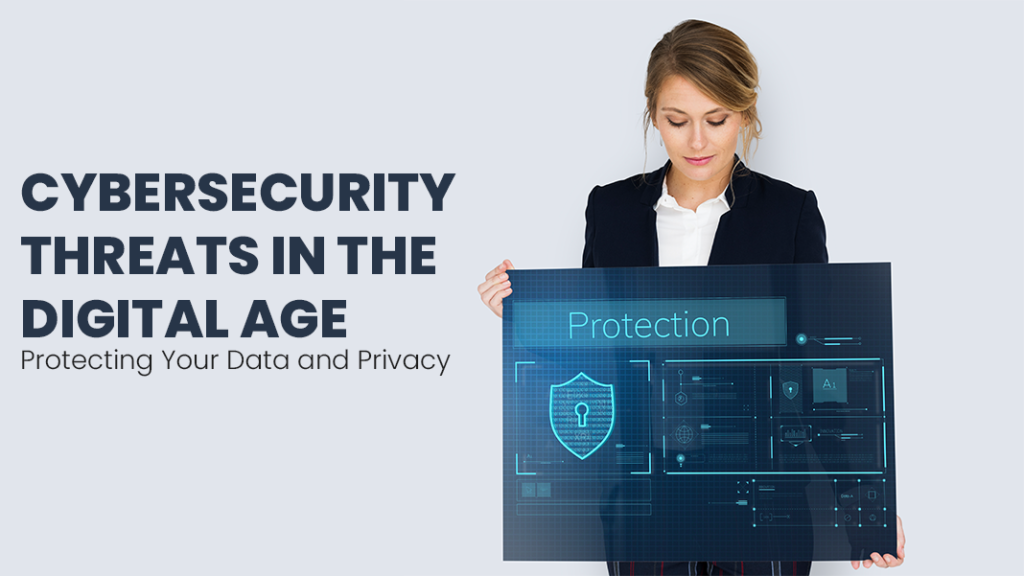Cybersecurity Threats in the Digital Age: Protecting Your Data and Privacy:
5 min read
.Cyber security concerns provide a serious risk to both individuals and organisations in the ever-changing digital environment of today. Protecting our data and privacy is more important. Than ever due to the rapid advancement of technology and the growing interconnectedness of gadgets. In this blog article, we’ll examine the numerous cyber security risks that exist in the modern world and talk about practical precautions you may take to safeguard your sensitive data.
The Changing Digital Landscape
The digital world is constantly evolving, offering new opportunities and conveniences. However, this dynamic environment also brings forth new cyber security threats. According to a Harvard Business Review (HBR) article, in order to stay up with new threats, the rate of development needs an equally quick evolution of cyber security measures. The Internet of Things (IoT), cloud computing, and smart devices have all proliferated, drastically increasing the attack surface for hackers.
Common Cyber Security Threats:
- a) Phishing and social engineering: Phishing attacks, in which attackers trick victims into disclosing sensitive information, continue to be a common cyber security issue. This is frequently accomplished through emails, messages, or phoney websites made to look like reliable sources. Social engineering strategies take advantage of human weaknesses to trick people into divulging private information or allowing unauthorised access.
- b) IoT Vulnerabilities: Cybercriminals now have a larger attack surface because to the spread of linked gadgets in our homes, businesses, and public areas. IoT devices are vulnerable to hacking because of weak security procedures and a lack of standardised protocols. Large-scale cyberattacks, such as Distributed Denial of Service (DDoS) attacks, can be launched using compromised IoT devices.
Protecting Your Data and Privacy:
A strong, unique password should be used for each online account: This is known as MFA (Multi-Factor Authentication). Complex passwords can be created and safely stored with the use of password managers. By asking users to submit additional verification, such. A fingerprint or a one-time code, when logging in, activating MFA also offers an additional layer of protection.
- b) Consistent Software Updates: It’s critical to keep your operating system, programmes, and antivirus software up to date. Security patches that fix flaws found by developers or security analysts are frequently included in software updates.
- c) Security Awareness and Training: It’s important to inform both oneself and one’s staff about typical cybersecurity dangers and best practises. This entails spotting phishing scams, being cautious when opening dubious links or attachments, and being alert to social engineering.
- d) Data Encryption and Backups: Important files should be frequently backed up and sensitive data should be encrypted in order to lessen the effects of a cyber assault. Data is protected using encryption to ensure that even if it is intercepted, it cannot be decoded without the encryption key. In the event of a system crash or ransomware attack, regular backups aid in data restoration.
Emerging Cyber Security Threats:
- a) Artificial Intelligence (AI) Attacks: Attacks using artificial intelligence (AI) are on the rise, and hackers are using these technologies to improve their attack strategies. AI-powered attacks can automate processes like spear-phishing, producing complex phishing emails that are difficult to spot.
- b) Internet of Things (IoT) Botnets: To avoid IoT devices being enlisted into botnets as they become more prevalent, it is crucial to secure them and put in place robust authentication procedures.
- c) Supply Chain Attacks: To get access to systems, supply chain attacks target the hardware and software supply chains. When cybercriminals breach reputable vendors or insert malicious code into valid software updates, attacks spread quickly. Numerous organisations and people who unintentionally install compromised software could be affected by these assaults.
- d) Insider Threats: Attacks or data breaches carried out by someone with permission to access sensitive data are referred to as insider threats. These people might be negligently causing security breaches unintentionally or with malevolent intent. Strict access controls, user activity monitoring, and routine security training can all aid in reducing the dangers brought on by insider attacks.
Strengthening Cyber security Defenses:
- a) Threat Intelligence and Monitoring: To keep up with the most recent cyber security threats and vulnerabilities, organisations should invest in strong threat intelligence platforms. Users’ behaviour, system records, and network traffic. Can all be continuously monitored to assist identify and quickly address any possible security incidents.
- b) Incident Response Planning: To lessen the effects of a cyberattack, a thorough incident response plan must be created. This strategy should outline specific steps for stopping the breach, looking into the occurrence, alerting the necessary parties, and putting systems back in a secure state. The effectiveness of the plan must be regularly tested and updated.
- c) User awareness and training: Human error continues to be one of cybersecurity’s weakest links. To inform employees about potential risks, safe browsing habits, and incident reporting procedures, organisations should give priority to cybersecurity awareness and training programmes. The likelihood of falling victim to phishing or social engineering attempts. Can be greatly decreased by routinely reminding users to practise cautious when communicating with unidentified sources.
Collaboration and information sharing are key to fostering a coordinated defence against ever-evolving threats. Information concerning cyber security dangers and best practices are shared across sectors and organisations. Collaboration can aid in the creation of standardised security frameworks, the sharing of threat information, and the sharing of expertise regarding efficient cybersecurity procedures.
To wrap it up:
Cybersecurity risks are always evolving and becoming more complex as the digital era goes on. A proactive strategy that combines technology safeguards, user education, and best practices is needed to protect your data and privacy. Both individuals and organisations can reduce their exposure to cyber hazards. By being educated about the most recent threats and putting in place the necessary security measures. Remember that readiness and attentiveness are essential in the dynamic world of cybersecurity.
The panorama of cybersecurity risks is continually changing in the current digital era, necessitating. That individuals and organisations remain aware and proactive in safeguarding their data and privacy. We may reduce the risks and possible effects of cyber assaults. By being informed of the newest dangers and putting in place thorough security measures such. As strong passwords, frequent software updates, encryption, and user awareness campaigns. Keep in mind that cybersecurity is a continuous effort and that protecting our digital lives requires us to adjust to the always-evolving threat landscape.





